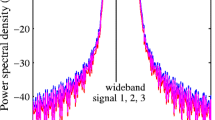Abstract
As an alternative to existing methods, we design a transform-domain algorithm to avoid the computational cost of a two-dimensional (2-D) spectral peak search when addressing the problem of joint azimuth and elevation directions-of-arrival (DOAs) estimation via an L-shaped array. Motivated by the linear prediction property of the signal cross-covariance matrix, the 2-D DOA estimation problem is equivalently converted into a 2-D frequency estimation problem. With the QR decomposition technique, the closed-form solutions in the transform domain with respect to the azimuth and elevation angles are successively estimated using the weighted least squared method as the solver, and it is shown that the proposed scheme achieves automatically pairing while permitting fast implementation. Simulations are presented to verify the effectiveness of the proposed method by comparison with several 2-D DOA estimators as well as the Cramér–Rao lower bound.






Similar content being viewed by others
References
F.K.W. Chan, H.C. So, W. Sun, Subspace approach for two-dimensional parameter estimation of multiple damped sinusoids. Signal Process. 92(9), 2172–2179 (2012)
H. Chen, C. Hou, W.-P. Zhu, W. Liu, Y.-Y. Dong, Z. Peng, Q. Wang, ESPRIT-like two-dimensional direction finding for mixed circular and strictly noncircular sources based on joint diagonalization. Signal Process. 141, 48–56 (2017)
A.M. Elbir, Two-dimensional DOA estimation via shifted sparse arrays with higher degrees of freedom. Circuits Syst. Signal Process. 38, 5549–5575 (2019)
A.M. Elbir, V-shaped sparse arrays for 2-D DOA estimation. Circuits Syst. Signal Process. 38, 2792–2809 (2019)
S.F. Hsieh, K.J.R. Liu, K. Yao, Applications of truncated QR methods to sinusoidal frequency estimation, in Proc. ICASSP., vol. 5 (Albuquerque, New Mexico, USA, 1990), pp. 2571–2574
Y. Hua, Estimating two-dimensional frequencies by matrix enhancement and matrix pencil. IEEE Trans. Signal Process. 40(9), 2267–2280 (1992)
L. Huang, Y. Wu, H.C. So, Y. Zhang, L. Huang, Multidimensional sinusoidal frequency estimation using subspace and projection separation approaches. IEEE Trans. Signal Process. 60(10), 5536–5543 (2012)
C. Jinli, G. Hong, S. Weimin, Angle estimation using ESPRIT without pairing in MIMO radar. Electron. Lett. 44, 1422–1423 (2008)
T. Li, A. Nehorai, Maximum likelihood direction finding in spatially colored noise fields using sparse sensor arrays. IEEE Trans. Signal Process. 59(3), 1048–1062 (2011)
Q. Liu, Y. Gu, H.C. So, DOA estimation in impulsive noise via low-rank matrix approximation and weakly convex optimization. IEEE Trans. Aerosp. Electron. Syst. 55(6), 3603–3616 (2019)
Q. Liu, W. Wang, D. Liang, X.P. Wang, Real-valued reweighted \(l_1\) norm minimization method based on data reconstruction in MIMO radar. IEICE Trans. Commun. 98(11), 2307–2313 (2015)
Q. Liu, X.P. Wang, Direction of arrival estimation via reweighted \(l_1\) norm penalty algorithm for monostatic MIMO radar. Multidimens. Syst. Signal Process. 29(2), 733–744 (2018)
Q. Liu, H.C. So, G. Yuantao, Off-grid DOA estimation with nonconvex regularization via joint sparse representation. Signal Process. 140, 170–176 (2017)
S. Liu, L. Yang, D. Li, H. Cao, Subspace extension algorithm for 2D DOA estimation with L-shaped sparse array. Multidimens. Syst. Signal. Process. 28, 315–327 (2017)
P. Stoica, K.C. Sharman, Maximum likelihood methods for direction-of-arrival estimation. IEEE Trans. Acoust. Speech Signal Process. 38(7), 1132–1143 (1990)
N. Tayem, K. Majeed, A.A. Hussain, Two-dimensional DOA estimation using cross-correlation matrix with L-shaped array. IEEE Antennas Wirel. Propag. Lett. 15, 1077–1080 (2015)
N. Tayem, H.M. Kwon, L-shape 2-dimensional arrival angle estimation with propagator method. IEEE Trans. Antennas Propag. 53(5), 1622–1630 (2005)
N. Xi, L. Liping, A computationally efficient subspace algorithm for 2-D DOA estimation with L-shaped array. IEEE Signal Process. 21(8), 971–974 (2014)
N. Xi, Q. Guobing, X. Xianbing, Z. Kai, Z. Kesheng, A 2-D DOA estimation algorithm for closely spaced sources with L-shaped array. Circuits Syst. Signal Process. 36, 4498–4511 (2017)
X. Zhang, L. Xu, L. Xu, D. Xu, Direction of departure (DOD) and direction of arrival (DOA) estimation in MIMO radar with reduced-dimension MUSIC. IEEE Commun. Lett. 14(12), 1161–1163 (2010)
G. Zhao, Z. Liu, J. Lin, G. Shi, F. Shen, Wideband DOA estimation based on sparse representation in 2-D frequency domain. IEEE Sens. J. 15(1), 227–233 (2015)
Z. Zheng, S. Mu, Two-dimensional DOA estimation using two parallel nested arrays. IEEE Communications Letters 24(3), 568–571 (2020)
Z. Zheng, W. Wang, Y. Kong, Y.D. Zhang, MISC array: a new sparse array design achieving increased degrees of freedom and reduced mutual coupling effect. IEEE Trans. Signal Process. 67(7), 1728–1741 (2019)
Z. Zheng, W. Wang, H. Meng, H.C. So, H. Zhang, Efficient beamspace-based algorithm for two-dimensional DOA estimation of incoherently distributed sources in massive MIMO systems. IEEE Trans. Veh. Technol. 67(12), 11776–11789 (2018)
Acknowledgements
This work was jointly supported by Fundamental Research Funds for Central Universities (Grand No. WUT: 2018 IVA 097) and the grant from the National Natural Science Foundation of China (Project No. 61771353).
Author information
Authors and Affiliations
Corresponding author
Additional information
Publisher's Note
Springer Nature remains neutral with regard to jurisdictional claims in published maps and institutional affiliations.
Rights and permissions
About this article
Cite this article
Cao, H., Liu, Q. & Wu, Y. Transform Domain: Design of Closed-Form Joint 2-D DOA Estimation Based on QR Decomposition. Circuits Syst Signal Process 39, 5318–5329 (2020). https://doi.org/10.1007/s00034-020-01416-8
Received:
Revised:
Accepted:
Published:
Issue Date:
DOI: https://doi.org/10.1007/s00034-020-01416-8




